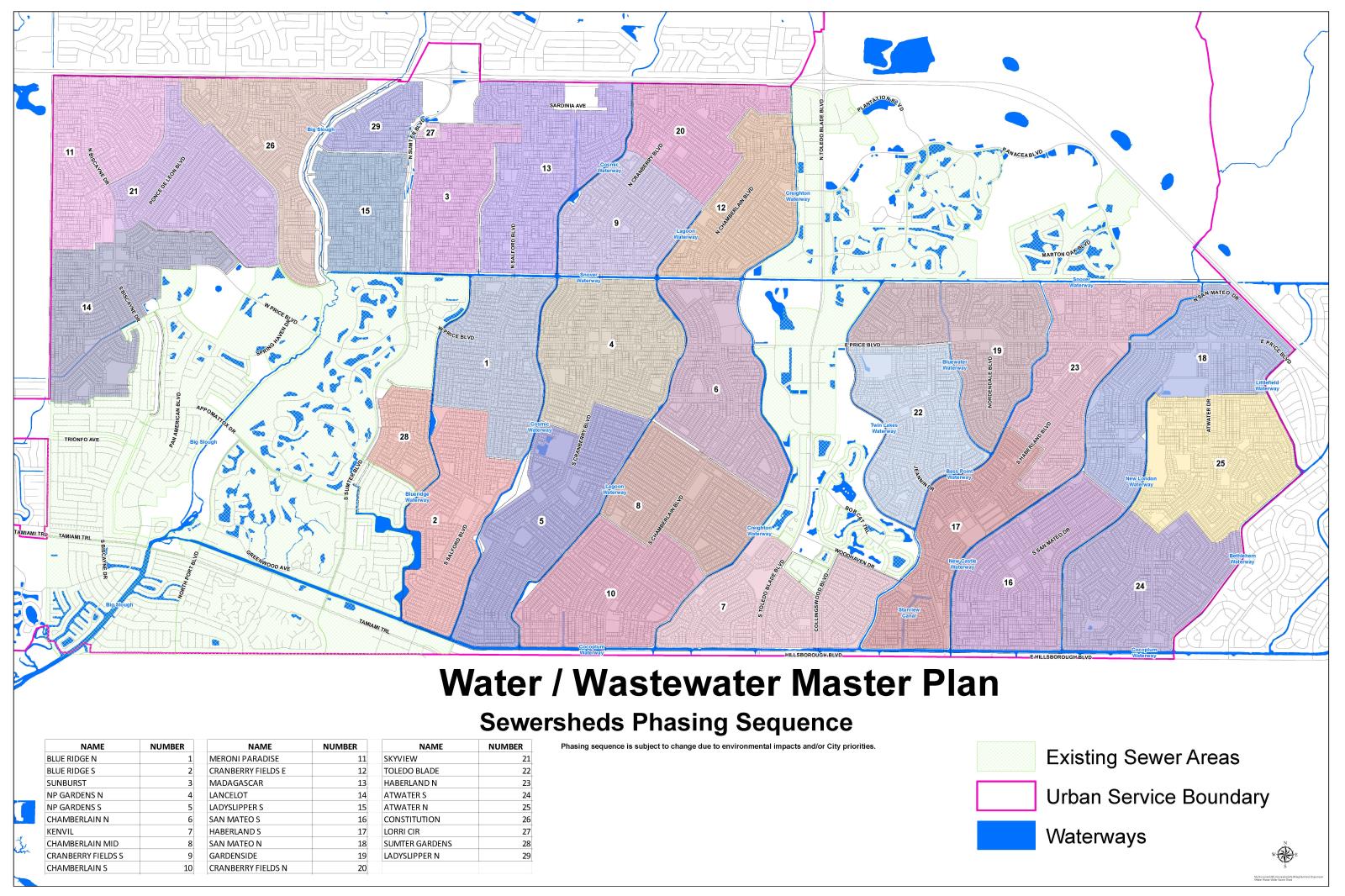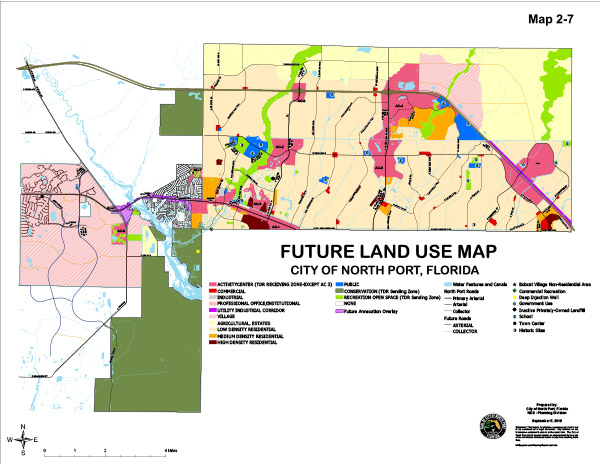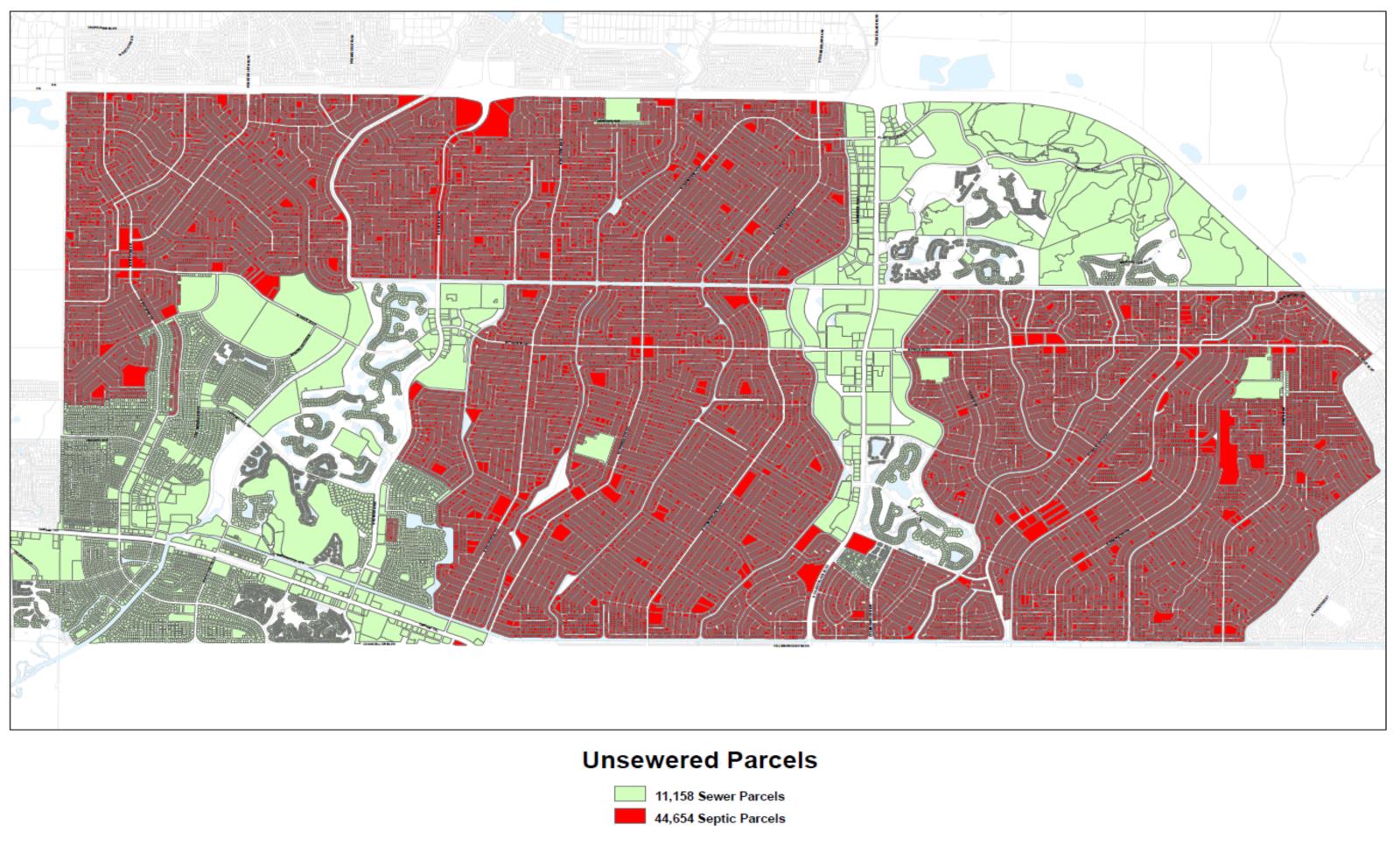Detailed Information
Septic Tanks
Failing Septic Tanks are Damaging Florida's Environment
What Role Do Septic Tanks Play in the Algae Bloom Crisis
Septic System Conversion to Central Sewer System(PDF, 1MB)
CHNEP Presentation: Reducing Septic Tank Pollution - Dr. Brian Lapointe
Clean Waterways Act
Governor Ron DeSantis Signs SB 712 “The Clean Waterways Act”
Nearly five decades ago, federal legislation was passed amending the Federal Water Pollution Control Act to not allow prolific, conventional septic tanks on platted ¼ acre lots. Unfortunately, North Port, as well as many other GDC communities had already been platted, bypassing this requirement. However, with the increasing nitrogen loads in our waterways and its effect on the environment, economy and our future, recent State of Florida legislation (Senate Bill 712) has been enacted to help address this.
Background Information
Growth took off in the North Port area after the General Development Corporation established the unincorporated community of Port Charlotte in the 1950s, offering affordable homes in Florida’s paradise to the rapidly expanding middle class. Attracted by the beautiful rivers, beaches, estuaries, and resources of Charlotte Harbor, the population grew rapidly in Charlotte County and increased from fewer than 5,000 in 1950 to over 170,000 residents today.
The population increase in North Port has impacted water bodies and rivers in both Sarasota and Charlotte Counties. The harbor’s historically pristine waters and thriving ecology are being threatened by excess nutrients, bacteria, viruses, dissolved oxygen, and toxic organic compounds; harmful algae blooms (HABs); and decreasing water clarity.
The Peace and Myakka Rivers, which flow through Charlotte County and discharge into the Upper Charlotte Harbor, and Charlotte Harbor are now listed as impaired by the US Environmental Protection Agency (EPA) for dissolved oxygen, chlorophyll-a, bacteria in shellfish, and mercury in fish tissue. Coastal water quality degradation is not limited to Charlotte Harbor. Numerous cities and counties along the Florida coast are experiencing eutrophication and HABs due to nutrient pollution. In 2012, the Florida Department of Environmental Protection (FDEP) adopted specific Numeric Nutrient Criteria (NNC) to protect the State’s estuaries and coastal areas from nutrient over-enrichment (Rule 62 302.532, Florida Administrative Code [FAC]).
| Nutrient |
Charlotte Harbor Proper |
Tidal Peace River |
Tidal Myakka River |
| Total Nitrogen (mg/L) |
0.67 |
1.02 |
1.08 |
| Total Phosphorus (mg/L) |
0.19 |
0.31 |
0.50 |
| Chlorophyll-a (µg/L) |
6.10 |
11.7 |
12.6 |
mg/L = milligrams per liter
µg/L = micrograms per liter
Table 1-1 lists the NNC for Upper Charlotte Harbor and the contributing rivers. Similar coastal areas and estuaries including Tampa Bay, Sarasota Bay, the Florida Keys, and Martin County have already begun implementing sustainable practices to restore their natural water resources and meet NNCs with measurable improvement (Ayers,1998; Lapointe and Herren, 2016).
The deteriorating water quality in Charlotte County has been largely attributed to nutrient and bacteria loads originating from on-site treatment and disposal systems (OSTDSs), more commonly referred to as septic systems (CHEC, 2003; Tetra Tech, 2013; LaPointe, 2016).
On December 7, 2020, the City Commission expressed their desire for staff to move forward with a plan to begin design for one portion of a “sewershed” area, called Blue Ridge-Salford North, the northern limit being the Snover Waterway, the western boundary being the Blueridge Waterway, the eastern boundary is the MacCaughey Waterway, the southern boundary in the vicinity of Radcliff and Lothlair Ave on the eastern side, up Salford and in the area of Cuthbert to the western side.
This is depicted as neighborhood “1” on map 4.1, page 8 of the preliminary cost estimates and general sequencing of master plan report provided to Commission on December 7, 2020, and has 1,583 total properties. The estimated date of completion for the first neighborhood is 25-30 years at current funding levels of $1 million per year. (Click below to view the sewershed map and estimated dates of completion.)

View expanded map of neighborhood "1"(PDF, 601KB)
On May 17, 2021, Commission approved the master plan for wastewater expansion and voted to move forward with the design of Phase 1 in the Blue Ridge area. Design is anticipated to take approximately 10 - 12 months. Construction would be bid, provided funding is available, once design is complete and the contract would be brought to Commission for approval. Once a contract is approved, construction would likely take another year to 18 months. All told, it will likely be at least 4 years until service will be available for this first segment.
Cost
City of North Port Commissioners have approved a maximum amount for existing homeowners who hook up to the municipal system during the construction process utilizing the early incentive program at $2,255 for wastewater and $5,654 for water and wastewater service. Commission also approved a 30-year payment plan and a hardship program. After construction is complete and the participation period for the early incentive program has passed, homeowners would be required to pay the full amount of the construction cost and capacity fees. Based on similar projects in neighboring communities, the estimated total construction cost without incentives, grants, and matching funding could be up to $35,000. To learn more about these programs, or to sign up, please contact North Port Utilities directly at 941-240-8000.
Why now
North Port, originally a General Development Corporation (GDC) community like Englewood, Cape Coral, Leigh Acres, Labelle, and Pt. St. Lucie, etc. only expanded water and sewer infrastructure as individual development occurred in the beginning, resulting in a fully serviced core area. The intention was to try to remain ahead of the growth with the infrastructure, but unfortunately, bankruptcy was declared in 1991 and the infrastructure held by GDC in the various cities were turned over by various means, to the respective governments. Now, some 60 years later, North Port is one of the only remaining GDC communities that has not implemented a plan to transition the platted lots to central sewer and water. According to World Population Review, North Port’s population is number 46 of the 410 incorporated municipalities in the State of Florida. As one of the largest cities within the state of Florida, as well as one of the top cities in the nation for growth and development, it is imperative that North Port address these environmental concerns.
Frequently Asked Questions
Is there a way we can view the December 7, 2020 Commission workshop when the Water and Wastewater Expansion Master Plan was discussed?
Yes, all City Commission meetings are viewable on the City’s website, including the December 7, 2020 Commission Workshop.
Is there a copy of the Preliminary Cost Estimates and General Sequencing of Master Plan report we could review?
Does the City intend to extend central water and wastewater to the North Port Estates area?
No. As shown on page 8 of the above report, the City’s Urban Service Area Boundary, marked in red, specifically excludes North Port Estates, Lake Geraldine, Orange Hammock and portions of the City out east, where either larger lots and/or existing sparse population can be supported by individual well and septic tanks. Therefore, extending central services to those areas is not planned or anticipated. Eventually, if the densities in the ¼ acre lots in the eastern portion of the City can no longer be supported by onsite infrastructure, Utilities would recommend a revision to the Urban Service Area Boundary to extend to the eastern boundary of the City.
Is central water and wastewater going to cost existing homeowners $35,000?
City of North Port Commissioners have approved a maximum amount for existing homeowners who hook up to the municipal system during the construction process utilizing the early incentive program at $2,255 for wastewater and $5,654 for water and wastewater service. Commission also approved a 30-year payment plan and a hardship program. After construction is complete and the participation period for the early incentive program has passed, homeowners would be required to pay the full amount of the construction cost and capacity fees which could total $35,000.
What about the on-site work, doesn’t that need to be done by a plumber?
Staff will be recommending that the construction be bid including the on-site costs to allow for the greatest savings possible. Those who choose to have the on-site work done at the time will benefit from the cost savings due to the economies of scale and will be allowed to include these costs in the 30-year payment plan. However, you will also be able to hire your own plumber if that is what you choose.
How is the City expecting to pay for the design for the first phase, is this coming out of my taxes?
Twelve years ago, the citizens of Sarasota County approved a penny tax to help fund infrastructure projects. One of the many infrastructure projects selected in North Port, as well as many other communities, was to extend central water and wastewater. The penny tax fund is the source of payment for the design and is one of the ways staff is recommending to help offset the future cost to connect for existing residents.
If this is being funded by Surtax, why do I have to pay, too?
At the rate that is dedicated from Surtax funds, it is estimated to take nearly a millennium to complete. While Utilities’ recommendation will be to offset existing residents’ contribution as much as possible, some portion will need to be funded by the residents to ensure timeliness. At some point in the future, the City will be forced to install central services, or stop issuing building permits in certain areas, or potentially in the entire City.
Isn’t the City going to run out of treatment capacity while trying to connect all the platted lots to the central water and wastewater systems?
The City has been master planning utilities for decades. For water, the City currently has 7.27 million gallons per day of capacity with another 1 million gallons per day being constructed in the West Villages Improvement District. The consumption currently being used is approximately 3 million gallons per day, and we have approximately 22,500 customers, so we have ample room to grow to serve tens of thousands of new connections. For wastewater, the City currently has 9 million gallons per day of capacity. The consumption currently being used is approximately 2.3 million gallons per day and we have approximately 18,500 customers, so we have ample room to grow to serve tens of thousands of new connections.
Why should I have to pay for new central water and wastewater that will benefit companies in North Port, shouldn’t they pay for their own connection?
The plan to extend central services to the platted lot areas does have the potential to benefit some of the neighborhood commercial, for instance, some of the red-designated properties on the map below. (View a larger, more detailed map.(PDF, 3MB))

The plan to extend central services to the platted lot areas does have the potential to benefit some of the neighborhood commercial, for instance, some of the red-designated properties on the map here. However, all of the properties within the Activity Centers, and even the neighborhood commercial that is required to connect to central services would be responsible for designing, permitting, installing and dedicating to the City, all utility infrastructure necessary to serve their developments. If an incoming commercial developer is not building on a property that was required to dedicate infrastructure to the City, they would then have to pay the same (proportional to their demand) amounts for line extensions as a residential property would incur, so they are either sharing the cost of the infrastructure or installing all necessary infrastructure themselves.
What about the extension of services to I-75, how are we paying for that?
This is a unique situation; one North Port has never done before. This Economic Development project is being funded out of Surtax and will be reimbursed to the fund from the commercial development that develop businesses out there. This is not being funded by any residents.
Are there other communities that are doing septic to sewer programs? Why does North Port have to be first?
North Port has consistently made investments and improvements in our wastewater infrastructure over the last three decades, maintaining and expanding a system that is nearly six decades old. However, on the residential septic side, some of which are not that much newer, it is uncertain if the same investments and improvements have been made, in addition to the fact that septic tanks do not reduce nitrogen and phosphorous, like central wastewater plants do. This combined with the high water table in Florida and density of some areas, can lead to nutrient issues. Many other similar communities with inadequate infrastructure, left by the bankruptcy of General Development Corporation have begun projects to some degree, to mitigate the environmental impacts of this situation. North Port is not first.
Properly working septic tanks do not do any damage to the environment, not nearly what central systems do, why would we want to expand central wastewater?
An individual properly working septic tank on sufficient land may not do damage to the environment. Concentrated septic tanks, as what exists, or will exist, in some areas of the City, can have a deleterious effect on the environment by increasing nitrogen reaching the surficial aquifer which ultimately intersects surface water bodies.

My well and septic tank are free and they work perfectly fine, why would I want to connect to central services?
Once installed a well and septic tank do not generate a monthly bill, however, they are certainly not free to operate. The well requires power to pump the water and ultimately both will need maintenance and repair. If water treatment equipment is deployed that adds to the maintenance and repair such as the addition of salt or other chemicals to the system. Maintenance and repair can run from a few hundred dollars to thousands of dollars if a new drainfield is required for the septic tank or the well needs to be deepened or re-drilled.
Will I be able to keep my well for irrigation purposes?
Doesn’t central water and wastewater reduce the value of my home for a future sale?
While we are not real estate professionals, generally lots/houses with central water and wastewater service available to them generally increase the value of the property.
I have seen a lot about Red Tide and Blue/Green Algae. What is the cause of these?
Blue green algal blooms and red tide have been in the news frequently over the last few years. The science on red tide blooms is still evolving and the level of anthropogenic inputs into the blooms have not been quantified, however it seems that it is a component of the issue. The blue green algal blooms are more directly tied to increased nutrient, nitrogen and phosphorus, levels in the freshwater waterways.
I have tasted North Port water and it tastes like chlorine. Why is there so much chlorine in North Port’s water and why would we want to expand central water when it tastes like chlorine.
Disinfection is required by the Safe Drinking Water Act. The City disinfects its potable water with chloramines and a residual is maintained in the distribution system, again required by law, to ensure that water remains safe from a microbial standpoint. The residual levels are less than the maximum allowed by the Safe Drinking Water Act.
Doesn’t a non-aerobic process breakdown the waste from a septic tank naturally?
Septic tanks are designed to breakdown the organic waste they receive. Septic tanks are not designed to removed nutrients. With enough drainfield and native soil the ammonia received by a septic tank is converted by bacteria to nitrate and then by different bacteria in the soil to nitrogen gas. If sufficient drainfield is not available the nitrogen cycle is not completed and the nitrate infiltrates ultimately ending up in waterways and increases algal and plant growth.
Aren’t septic tanks made to back up into your house, not go into the environment?
No, septic tanks are designed to drain homes, breakdown the organic waste and ‘leach’ the water via a drainfield.
Doesn’t the EPA’s website explain that septic tanks work just fine?
Yes, the EPA has this information on their website, however, the first sentence explains that septic systems are commonly used in rural areas without centralized sewer systems. North Port agrees, rural areas, like in the North Port Estates area and the platted lots east of the Urban Service Area boundary meet these criteria and are currently not planned for central systems. Due to the size of the lots, the North Port Estates area and Lake Geraldine are the two areas in North Port that will always be on well and septic.